3D Workflow Introduction
Table of Contents
This side will give you a quick introduction into the 3D world of Ventuz, and where you can find familiar things like texture channels, or how to import your assets, to start right away working on your projects.
Introduction
There are multiple ways to effectively work in 3D inside the Ventuz Designer. The most common workflow for more complex 3D models is using a third party tool like Blender or Cinema4D for the modeling and animating part, followed by texturing in substance painter for example and importing the finished model into the Designer. But it is also possible to texture your assets directly inside Ventuz, since it has many functionalities that are very helpful. Like many UV mapping options. Or the .sbsar support to quickly import Substance Designer textures into Ventuz. It is also possible to Live Link a asset with the help of Cinema4D for a even quicker workflow. Animating can also be done beforehand or by using the strong Animation Editor inside Ventuz to be able to make non linear Animations.
We will cover the following in this introduction:
Geometry Import
Generally speaking the import of a 3D asset from a geometry file is done very quickly by just dragging and dropping it from the Windows File Explorer into the Hierarchy Editor in Ventuz. For more supported 3D formats see further below.
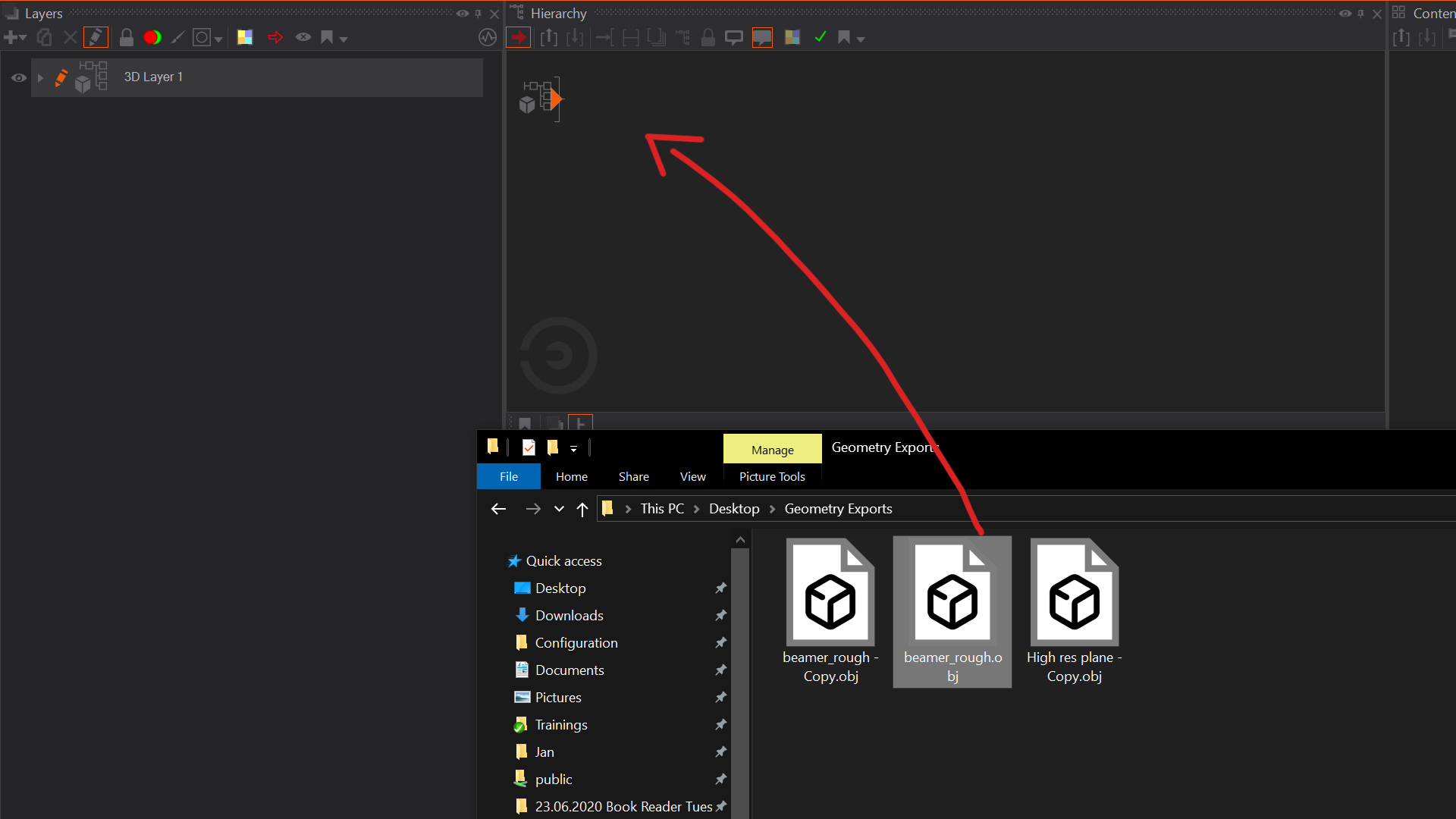
If you do not see anything in the Renderer Window that is probably because the units of the object are not set correctly to 1 Meter. So your object might be either very small or very big.
Always use 1 Meter as 1 Unit so your object keeps the right scaling.
For now you can just change the scaling of the first axis in your geometries tree in the Property Editor if you encounter this problem.
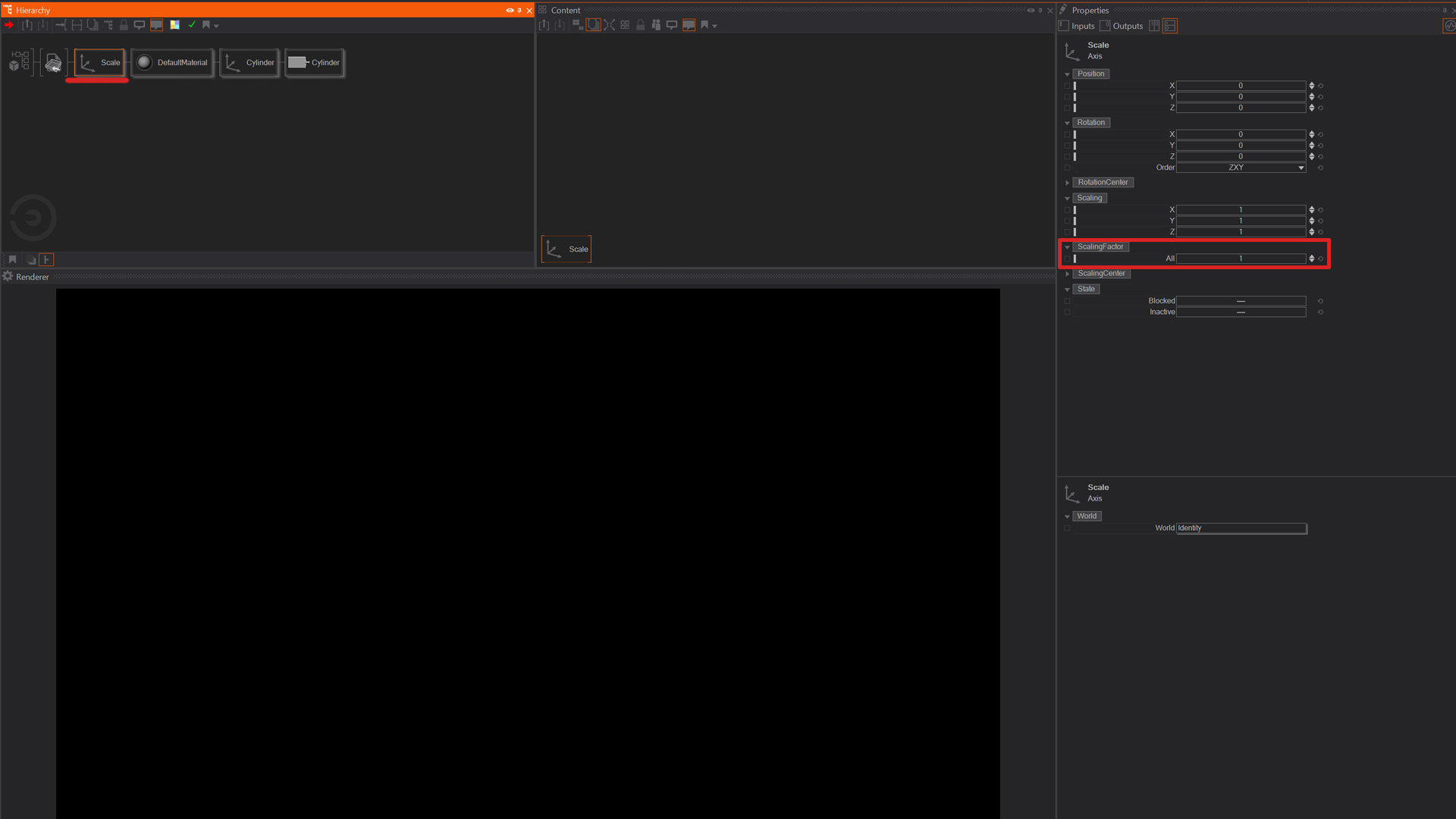
It is also possible to do it the other way around by grabbing a Geometry import node from the toolbox, clicking on the asset property and searching for your asset with the file explorer.
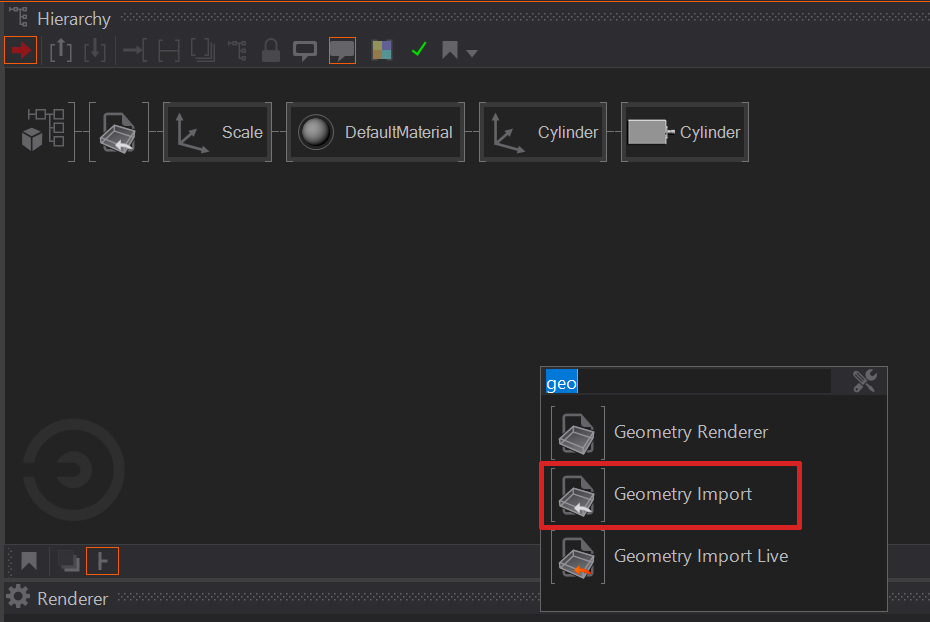
As you can see when there is no texture provided with the mesh Ventuz will just skip it (warn you with an error) and add a default material. Depending on the complexity of the mesh there will be more objects in the hierarchy editor. Ventuz will never merge meshes and will always display every mesh with its own axis and the corresponding name.

Geometry Live Import
Another way of working with your 3D models is the Live import.The Cinema 4D plugin for Ventuz is included with the Ventuz installer. After you've installed Ventuz, simply locate your install folder and run Cinema4dPluginInstaller.exe and follow the on-screen instructions.
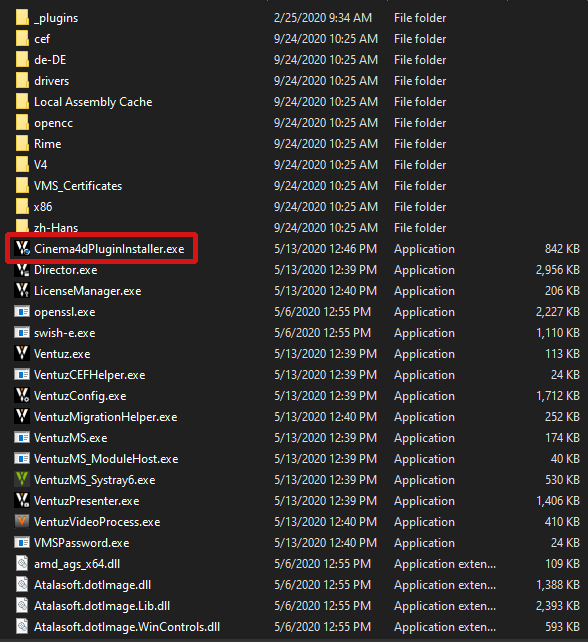
Cinema 4D must be opened once before the installation of the plugin!
For a detailed description of how the Live Link works take a look right here.
Materials
In the following short introduction into Materials you will learn about Material Stages. These are commonly referred as texture channels in most 3D Applications. You will find them directly in the Material that Ventuz created for you after the import of any 3D object. Or just grab a Material Node via the Toolbox.
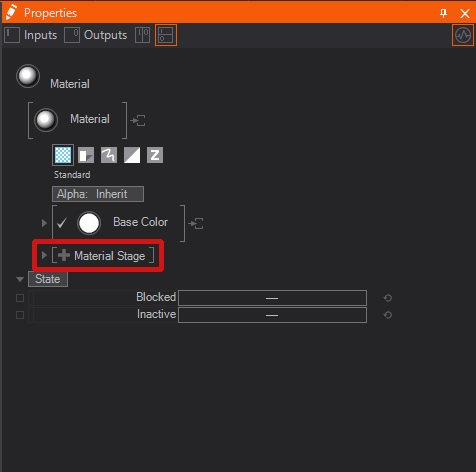
By clicking on the small plus you can add a new stage. There under Texture you will find many different types which you might be familiar with already.
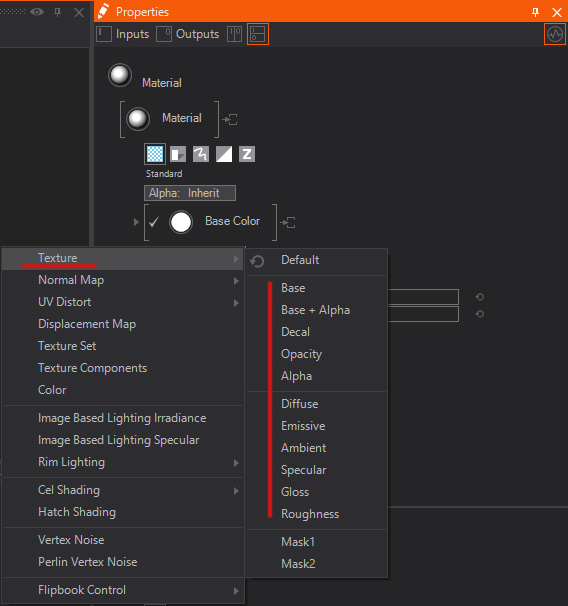
With this you can add as many stages onto the material as you need. Since Ventuz 6.4 we also added the possibility to use Substance Materials (.sbsar) which can easily just be drag and dropped into the hierarchy editor.
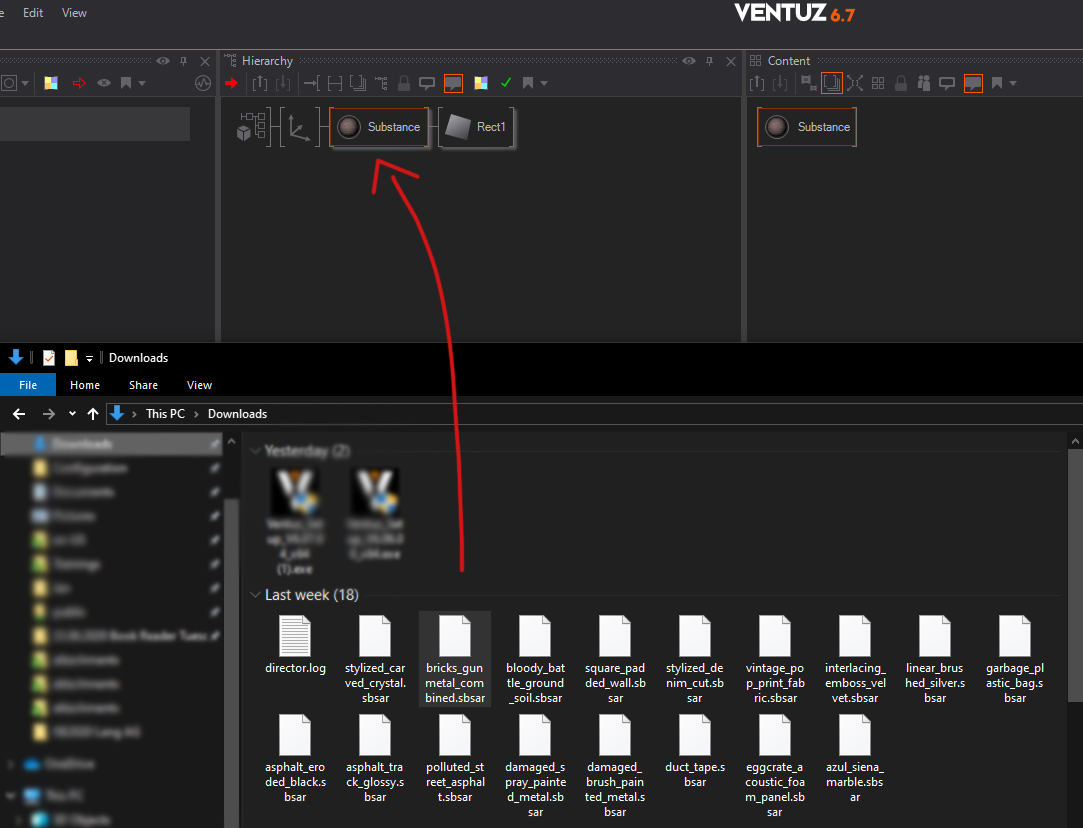
A good source for those textures is https://source.substance3d.com/, if you have a abo of there software you get free points every month to download high quality textures which can be used for commercial projects as well. These textures have predefined properties which you can change in Ventuz as well. You will find them in the properties window after clicking on the just imported texture in the hierarchy editor.
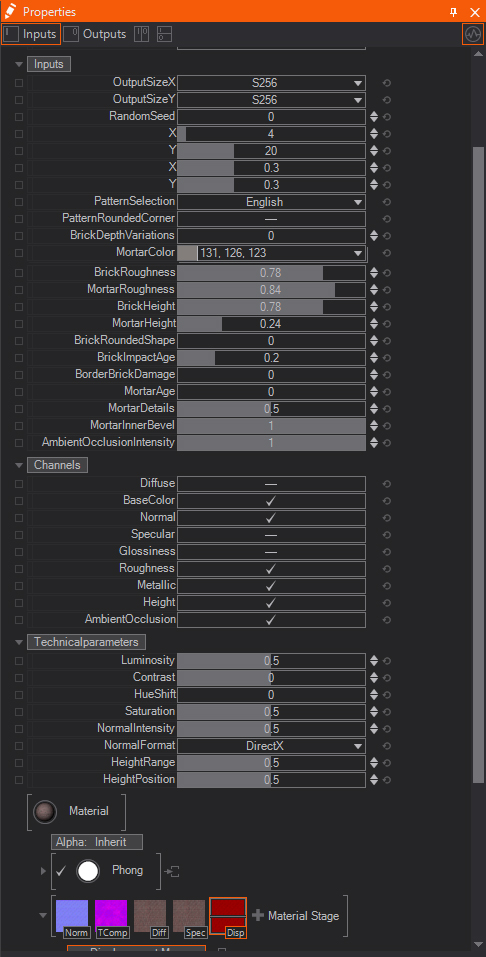
This is different from texture to texture depending on what the artist exposed while building it.
There are some things to keep in mind when working with such Materials. for a detailed description on Substance materials click here. We also have a How to where you can learn to use the Substance integration right here.
To learn more about the Material stages and its possibilities take a look right here.
Animations
Animating is one of Ventuz strong suites due to its non linear nature. But covering this completely in this how to would be to much. There are several ways to animate in Ventuz. You can either import your animations directly with a .fbx from a third party 3D programm. Or do it directly inside the Designer. We recommend reading trough this page to get a deep look into everything related.
Or watch this Video for a short introduction: https://youtu.be/jnmG8nRs7mY
Supported Formats
Geometries
The following file formats can be imported into Ventuz to create complex geometries.
| File Extension | Name | Version |
|---|---|---|
| .gltf / .glb | GL Transmission Format | only v2.0 |
| .3ds / .prj | 3ds Max 3DS | all |
| .ase / .ask | 3ds Max ASE | all |
| .dae / .zae | Collada (zipped) | up to 1.5 |
| .fbx | Autodesk | up to 2013 |
| .obj | Wavefront | all |
| .stl | Stereo Litho | all |
| .stp | Step Files | all |
Some information on the formats mostly used:
GLTF
The glTF Transmission Format is a royalty-free specification for efficient transmission and loading of 3d scenes, models, textures/materials and animations. The format is introduced by the Khronos Group. It defines a streamlined authoring workflow and enables the interoperable use of the content across different software packages and platforms. The importer itself supports the glTF2 standards like:
- meshes
- materials
- cameras
- scenes
- SRT animations
- skeletal animations
- skinned characters/meshes
Limitations currently are:
- mesh morph targets not supported
- reimport is only possible in a constrained way
Reimporting a scene can be done as long as the order of the objects in the file did not change. This is since glTF2 doesn't have unique IDs for elements.
The following glTF extensions are supported:
| Extension | description |
| KHR_blend | advanced alpha blending modes such as additive or multiplicative |
| KHR_lights_punctual | support for directional/point/spot lights in the scene |
| KHR_materials_emissive_strength | PBR only: set the gain of the emissive channel |
| KHR_materials_pbrSpecularGlossiness | slightly more flexible way to define materials than the default base-metallic-roughness materials |
| KHR_materials_unlit | no light, everything except base color and texture is ignored |
| KHR_texture_transform | scale, rotate and translate for texture coordinates |
| MSFT_texture_dds | Microsoft extension to use DDS textures, e.g. for compressed or HDR textures |
3DS
The 3DS format was used by the 3D Studio DOS version and has been replaced with the first release of 3DS Max. This format is still used as interexchange format for several modeling software suites. Keep in mind that this format has big limitations compared to the OBJ file format. See wiki for a detailed limitations (shortcomings).
ASE
ASE stands for ASCII Scene Exporter and is a the native file format from 3D Studio Max, ActorX and Maya.
Please do not mix it up with the Adobe Swatch Exchange file format!
DAE / ZAE (COLLADA)
The COLLADA Digital Asset Exchange format was introduced by Sony Computer Entertainment and is now maintained by the Khronos Group. Collada defines an open XML-based database scheme that enables 3-D authoring applications to freely exchange digital assets without loss of information, enabling multiple software packages to be combined into extremely powerful tool chains. Currently, all of the important DCC tools have either built-in exporters for the Collada format or there exist third-party plug-ins. Collada is a very powerful and flexible 3D format which seems to be evolving to an industry standard. In addition to common 3D features, the Collada specification supports, amongst others, animations, shaders and physics. In the current version of the Collada importer, Ventuz supports the import of geometry, materials and textures. All other Collada features are not supported yet. Currently we support also the .zae extension, which is basically a zipped dae file including textures.
OBJ
The OBJ file format was introduced by Alias/Wavefront and is similar in status to the 3DS format, in that it is somewhat antiquated and unreliable. The OBJ file only stores geometry information. The material and texture properties are stored in a separate file, it is the .MTL file. This file is referenced from the OBJ file. If your imported model is missing materials and textures, check if the according .MTL file exists.
FBX
The Filmbox format. This format can include Texture/Materials and SRT animations. if you have any issues using this format please try to use the 7.3 (2013) version of FBX.
STL / STP
The "Stereo Litho" and STEP format are used for FDM and CAM as well as a standard exchange between CAD and CAM programs. We support the Binary and ASCII representations. These formats include just triangles - no support for materials or textures is given.